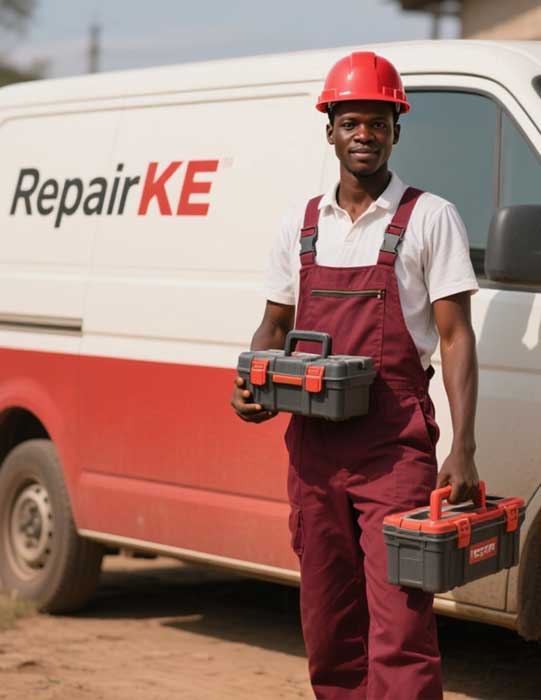
Washing Machine Belt Slipping or Broken - Reasons and How We Fix It
A slipping or broken washing machine belt can disrupt laundry routines, causing the drum to malfunction or stop spinning entirely. Repair.co.ke, a trusted appliance repair service in Kenya, specializes in diagnosing and resolving such issues efficiently. This article explores the common reasons behind belt problems in washing machines and outlines the professional solutions provided by Repair.co.ke to restore optimal performance.
"A faulty belt can halt your washing machine’s spin cycle, but timely repairs can extend its lifespan." – Repair.co.ke Technician
Understanding the Role of the Washing Machine Belt
The belt in a washing machine connects the motor to the drum, enabling it to spin during wash and spin cycles. Typically made of rubber or reinforced materials, the belt is subject to wear and tear over time. When it slips or breaks, the drum may rotate weakly, make unusual noises, or fail to move, leading to incomplete cleaning or water drainage issues. Repair.co.ke identifies belt-related problems as a frequent cause of washing machine malfunctions.
"The belt is the heart of the washing machine’s motion system, and its condition directly affects performance." – Appliance Repair Expert
Common Reasons for Belt Slipping or Breaking
Several factors contribute to a washing machine belt slipping or breaking, each requiring specific diagnostic approaches:
Wear and Tear
Over time, the belt naturally degrades due to constant tension and friction. Frequent overloading or heavy use accelerates this process, causing the belt to stretch, fray, or snap. Repair.co.ke technicians often find worn belts in older machines or those used for bulky items like blankets.
Misalignment or Loose Tension
A misaligned or improperly tensioned belt may slip off the pulleys, reducing its grip and causing erratic drum movement. This can result from improper installation, loose motor mounts, or pulley wear. Such issues produce squealing or grinding noises during operation.
Overloading the Machine
Consistently overloading the washing machine puts excessive strain on the belt, leading to slippage or breakage. Repair.co.ke advises adhering to the manufacturer’s load capacity guidelines to prevent undue stress on the belt and other components.
Pulley or Motor Issues
Damaged or worn pulleys can cause the belt to slip or wear unevenly. Similarly, a malfunctioning motor may exert inconsistent power, affecting belt performance. These issues require professional inspection to pinpoint the root cause.
Foreign Objects or Debris
Small objects, such as coins or buttons, can lodge in the drum or pulley system, causing the belt to slip or break. Repair.co.ke technicians frequently encounter debris-related belt damage in machines without regular maintenance.
"Overloading your washing machine not only risks belt damage but also strains the motor and bearings." – Repair.co.ke Service Manager
How Repair.co.ke Fixes Belt Issues
Repair.co.ke employs a systematic approach to diagnose and resolve washing machine belt problems, ensuring durable repairs and customer satisfaction. The process includes:
Comprehensive Diagnosis
Technicians begin by inspecting the washing machine to confirm whether the belt is slipping, broken, or affected by related issues. They check for signs of wear, misalignment, or debris and assess the condition of pulleys and the motor. Diagnostic tools, such as tension gauges, help determine if the belt’s tension is within manufacturer specifications.
Belt Replacement
If the belt is damaged or excessively worn, Repair.co.ke replaces it with a high-quality, manufacturer-approved part. Technicians ensure the new belt is compatible with the machine’s model and properly aligned to prevent future slippage. For minor wear, adjustments to tension or pulley alignment may suffice.
Pulley and Motor Repairs
When pulleys or the motor contribute to belt issues, technicians repair or replace these components. Worn pulleys are resurfaced or swapped, and motor issues, such as electrical faults, are addressed to restore consistent power delivery.
Debris Removal and Maintenance
Foreign objects or debris are carefully removed from the drum, pulleys, or belt path. Repair.co.ke also performs preventive maintenance, such as cleaning internal components and lubricating moving parts, to reduce the risk of future belt problems.
Testing and Calibration
After repairs, the washing machine is tested through multiple cycles to verify smooth operation. Technicians check for proper drum rotation, absence of unusual noises, and correct spin speeds. This ensures the belt and related systems function optimally.
"Professional repairs can save you from costly replacements by addressing belt issues early." – Home Appliance Consultant
Preventive Tips from Repair.co.ke
To minimize belt-related problems, Repair.co.ke recommends regular maintenance and mindful usage:
- Avoid overloading the machine and distribute laundry evenly.
- Check pockets for small items before washing.
- Schedule periodic professional maintenance to inspect belts, pulleys, and motors.
- Address unusual noises or weak spinning promptly to prevent further damage.
"Routine maintenance can double the lifespan of your washing machine’s belt and other critical components." – Repair.co.ke Maintenance Specialist
Why Choose Repair.co.ke?
Repair.co.ke stands out for its expertise, prompt service, and commitment to quality repairs. With a team of skilled technicians and access to genuine spare parts, they ensure washing machines are restored to peak performance. Their customer-centric approach and transparent pricing make them a trusted choice for appliance repairs across Kenya.
Contact Information
For expert washing machine repairs, contact Repair.co.ke:
- Website: repair.co.ke
- Email: info@repair.co.ke




